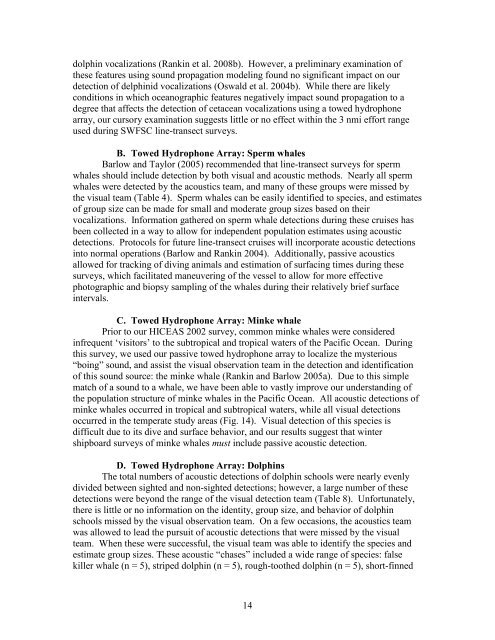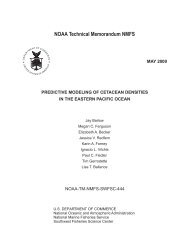NOAA Technical Memorandum NMFS - Southwest Fisheries ...
NOAA Technical Memorandum NMFS - Southwest Fisheries ...
NOAA Technical Memorandum NMFS - Southwest Fisheries ...
Create successful ePaper yourself
Turn your PDF publications into a flip-book with our unique Google optimized e-Paper software.
dolphin vocalizations (Rankin et al. 2008b). However, a preliminary examination of<br />
these features using sound propagation modeling found no significant impact on our<br />
detection of delphinid vocalizations (Oswald et al. 2004b). While there are likely<br />
conditions in which oceanographic features negatively impact sound propagation to a<br />
degree that affects the detection of cetacean vocalizations using a towed hydrophone<br />
array, our cursory examination suggests little or no effect within the 3 nmi effort range<br />
used during SWFSC line-transect surveys.<br />
B. Towed Hydrophone Array: Sperm whales<br />
Barlow and Taylor (2005) recommended that line-transect surveys for sperm<br />
whales should include detection by both visual and acoustic methods. Nearly all sperm<br />
whales were detected by the acoustics team, and many of these groups were missed by<br />
the visual team (Table 4). Sperm whales can be easily identified to species, and estimates<br />
of group size can be made for small and moderate group sizes based on their<br />
vocalizations. Information gathered on sperm whale detections during these cruises has<br />
been collected in a way to allow for independent population estimates using acoustic<br />
detections. Protocols for future line-transect cruises will incorporate acoustic detections<br />
into normal operations (Barlow and Rankin 2004). Additionally, passive acoustics<br />
allowed for tracking of diving animals and estimation of surfacing times during these<br />
surveys, which facilitated maneuvering of the vessel to allow for more effective<br />
photographic and biopsy sampling of the whales during their relatively brief surface<br />
intervals.<br />
C. Towed Hydrophone Array: Minke whale<br />
Prior to our HICEAS 2002 survey, common minke whales were considered<br />
infrequent ‘visitors’ to the subtropical and tropical waters of the Pacific Ocean. During<br />
this survey, we used our passive towed hydrophone array to localize the mysterious<br />
“boing” sound, and assist the visual observation team in the detection and identification<br />
of this sound source: the minke whale (Rankin and Barlow 2005a). Due to this simple<br />
match of a sound to a whale, we have been able to vastly improve our understanding of<br />
the population structure of minke whales in the Pacific Ocean. All acoustic detections of<br />
minke whales occurred in tropical and subtropical waters, while all visual detections<br />
occurred in the temperate study areas (Fig. 14). Visual detection of this species is<br />
difficult due to its dive and surface behavior, and our results suggest that winter<br />
shipboard surveys of minke whales must include passive acoustic detection.<br />
D. Towed Hydrophone Array: Dolphins<br />
The total numbers of acoustic detections of dolphin schools were nearly evenly<br />
divided between sighted and non-sighted detections; however, a large number of these<br />
detections were beyond the range of the visual detection team (Table 8). Unfortunately,<br />
there is little or no information on the identity, group size, and behavior of dolphin<br />
schools missed by the visual observation team. On a few occasions, the acoustics team<br />
was allowed to lead the pursuit of acoustic detections that were missed by the visual<br />
team. When these were successful, the visual team was able to identify the species and<br />
estimate group sizes. These acoustic “chases” included a wide range of species: false<br />
killer whale (n = 5), striped dolphin (n = 5), rough-toothed dolphin (n = 5), short-finned<br />
14









